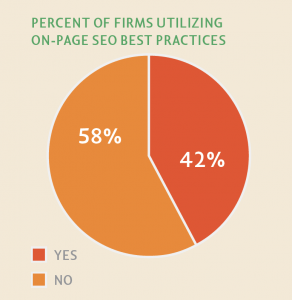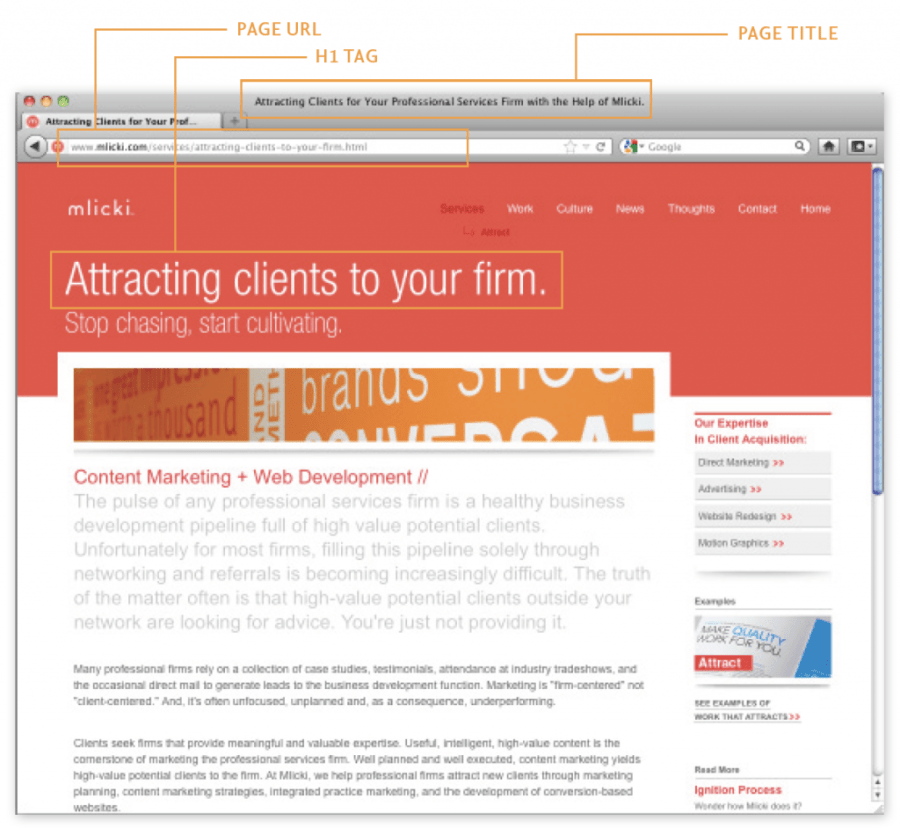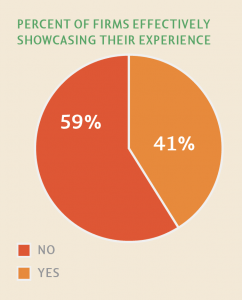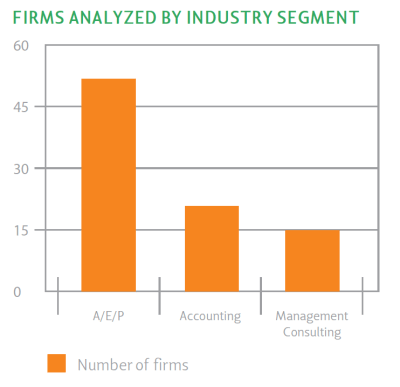It’s just not Kansas anymore
It’s hard to believe that the web has been a widely accepted commercial medium for almost 20 years. When we compare today’s hyper-robust, content-oriented, mobile-ready, searchable Internet to its antiquated static predecessor of the mid ‘90s, it’s hard to recognize the two as even distant cousins.
IS YOUR WEBSITE A SOURCE OF FRUSTRATION?
The rapid evolution of the web has left a lot of firms feeling overwhelmed and increasingly uncertain. When we talk to firm leaders about the role of their website in their business, we hear the frustration firsthand. Any firm that’s been around for the last 20 years, has probably been through at least 3-4 major website redesigns. With each overhaul, the frustration grows.
“Didn’t we just do this a few years ago? Why are we doing it again? Are we getting value from this? No one buys our services over the web anyway; we just need something to let prospective clients know we exist and demonstrate our credibility.”
IT SHOULD BE A SOURCE OF ADVANTAGE.
At Mlicki, we believe your site should be a source of sustained competitive advantage. It should be creating opportunity for your firm beyond your typical geographic markets. It should be introducing you to prospects you’ve never met. It should be the definitive, undisputed source of your firm’s collective expertise and previous experience. It should function at all phases of the buying cycle. It should delicately convert casual visitors into qualified leads for your business development function. It should give you visibility into where those prospects are in the buying process. And, it could be the source of upwards of 10-15% of your firm’s new business won every year. Unfortunately, it rarely is.
ABOUT THIS HANDBOOK
This handbook is based on an analysis of the websites of 85 middle market professional services firms operating in the United States. Research was completed during June 2012 by the Mlicki team, and firms were selected from the following industries: A/E/P, accounting and management consulting. Included is an overview of what a high value website looks like, the six critical website mistakes seen most often in the professional services marketplace, and conclusions on what it all means.
Where websites add value
A modern marketing website creates the most value at the beginning of a client’s buying process and its role should wane as she moves further towards a decision. In the end, your website should add significant value in two ways:
1. ATTRACT CLIENTS WHO DON’T KNOW YOU
This is the value the website creates at the earliest stages of the buying process. It’s assisting to generate potential leads for the business development team, it’s helping to build the firm’s pipeline, and as a result it is actively contributing to the firm’s annual bookings and revenue. It’s attracting potential clients who don’t know you, engaging them over time through informative content, and nurturing them in such a way that you’re able to identify high value (and low value) prospects for the business development team. For many firms, especially A/E firms, this role is a rather new one for your site, and it may not be doing this much or at all right now.
2. HELP CLOSE BUSINESS WITH PROSPECTS WHO KNOW YOU
This second role is really to augment the firm’s traditional marketing and business development efforts that occur primarily offline. These are prospects who have determined largely through other means that they need a firm like yours, know your firm based on your existing marketing and business development efforts, and are visiting your site to gauge how credible and capable your firm appears to be relative to the expertise they’re seeking. In this role, the site is functioning relatively late in the prospect’s buying process and is a somewhat passive participant in your own business development process. Your site has likely been filling this role for almost 20 years.
Web content and the buying process
In order to create value at all phases of the buying process, your site needs to provide three types of valuable content:
1. EXPERTISE-ORIENTED CONTENT
This type of content exists in the form of blog posts, articles, branded research studies, white papers, and webinars. Your firm uses this educational content to cast a net to attract prospective clients to your site via search. This content becomes the definitive source and proof of your expertise. It is used solely to educate and inform. It allows prospective clients to learn about the potential issues you solve and understand how you solve them. More importantly, it allows prospects to start the process of diagnosing their business issues.
2. MOTIVATIONAL CONTENT
This content largely takes the form of short-form case studies and testimonial videos. It logically follows your educational content from the perspective of the buying process – a prospect finds your large volume of useful, informative, and educational content, self diagnoses a need you can solve and resolves himself or herself to do something about it. Your motivational content inspires him or her to move forward, ideally with your firm. It is critical to execute well in that it helps you move your prospect down the funnel and gives them the inspiration they need to move forward. In that regard it functions as a linchpin between your educational content and your business development team.
3. EXPERIENCE-ORIENTED CONTENT
This is content that outlines who the firm is, what it does and who it has done it for in the past. It includes such things as corporate history, founding philosophies, service offerings, project profiles, firm news, and bios of firm leaders and consultants. This is the stuff that should have been on your first website from nearly 20 years ago. This is the content used to accomplish the second role of your marketing website – helping to close business with prospects who already know you. A prospect with an already determined need who knows your firm is really just using your site to gauge your experience and the content outlined above is sufficient to move your business development efforts to the next step of that process.
Number One
Non-Searchable Content
Almost all of the larger A/E/P firms relied heavily on branded publications as part of their content strategy. These branded publications often take the form of magazines that are published on a semi-regular basis. While a growing number of firms have abandoned these publications during the recession, a great many are still publishing them with less frequency. Most of these publications are printed ones and are distributed to prospective clients offline and then posted online in a PDF format. Many accounting and consulting firms are also still posting newsletters, articles, and research reports in a PDF format as well. Most of these publications provide lots of high value educational content that could be an asset to attract potential clients that might otherwise not have considered the firm. The problem is that the PDF format renders that content all but invisible to a search engine.

Transferring this content into an HTML format would create significant improvements in firms’ search traffic. A second, but less common, mistake is posting much of this valuable content behind password protected login systems or contact fields. Some of the worst offenders even asked users to create a password or provide information in order to read a project profile or case study. The only content that users are regularly willing to provide their personal information in exchange for is research-oriented, educational content that is deemed of high value. Unfortunately, a firm’s case studies will likely never fit that bill.
Number Two
Not enough content
Even those firms that are producing valuable, educational content simply aren’t producing enough of it. All too often, we found blogs that hadn’t been updated in 5-6 months or blogs with a small handful of articles. Until your firm is committed to sustaining a healthy volume of content as part of its business strategy, it should resist temptations to implement systems for content. The amount of high value educational content you’re able to produce over time will be the single most critical element in accomplishing the first goal of your marketing website – attracting clients who don’t already know you to your firm. To accomplish this task, your firm needs to be prepared to add a minimum of 2,000 words of useful, high value content to your website on a monthly basis, according to Mark O’Brien at Newfangled Web Factory.
In all, only 20% of the firms that are producing expertise- oriented content are doing so with the searchability and frequency necessary to derive significant business value from the activity.
Number Three
Neglecting basic on-page SEO best practices
Surprisingly, only 42% of firms are practicing basic search engine best practices on their site pages. This is a bit of a shock given that the firms reviewed certainly have the resources to do better, but have simply neglected to do so. In some cases, firms have made significant
investments in content management systems, yet have neglected some of the most basic search elements necessary to make that content both indexable and searchable.

THE BASICS OF SEARCH
Much of what we know about search we’ve learned and adapted from Mark O’Brien’s team at Newfangled Web Factory. Mark advocates for a form of search he calls expertise-oriented search. Mark writes about this in some detail in his book, A Website that Works. In this book he provides considerable background on how Google works. For the purposes of this handbook, I’ll provide a short summary here.
Expertise-based search is both simple in intent and effective in action. That said, it requires a commitment to producing a steady stream of useful content your prospects will find valuable. From a technical perspective, Mark recommends tending to three critical elements that Google regularly accesses on a page to understand its content. These are:
- Page Title – The name of the page that appears at the very top of your browser.
- Page URL – The physical web address of the page.
- H1 Tag – Likely the headline on the website page.
AN EXAMPLE OF EFFECTIVE ON-PAGE SEARCH ELEMENTS
The key is to look at these three elements together and ensure that all three are telling a consistent story to Google. Let’s look at one of the high level service-offering pages on the Mlicki site as reference. The page I speak of is about Client Attraction. Above is a screenshot of this page along with highlights to designate the three critical elements of search on this page:
- Page Title – Attracting Clients for Your Professional Services Firm with the Help of Mlicki.
- Page URL – www.mlicki.com/services/attracting- clients-to-your-firm.html
- H1 Tag – Attracting clients to your firm.

This page presents a very clear story to Google that it can quickly index and understand. As a result, a Google search along the lines of “attracting clients to a firm,” generally yields this page on the first page of search results.
TYPICAL MISTAKES MADE BY FIRMS
Most firms will get one or two of these three components correct, but will be unsuccessful at combining all three. The most prominent mistakes we saw in our analysis:
- Non-search friendly URLs – Many CMS platforms are built or customized by developers who focus on using the system to manage content, but not necessarily to make that content search-friendly.
- Improper use of page titles – Often, firms fail to make use of the page title at all. Many sites have completely neglected this element of the site and have left the page titles on every page simply the firm’s name. As a result, Google is forced to try and discern what each page is about with incomplete information.
Number Four
Relying too much on past experience
Surprisingly, only a minority of firms (~40%) are doing an effective job of showcasing their experience. Most accounting and consulting firms offer no case studies or demonstrable evidence at all of the impact of their work. On the other hand, most A/E/P firms rely almost exclusively on their portfolio of work to sell their services. The reason is obvious — consulting services are completely nebulous and largely intangible; by contrast, architecture and engineering services result in tangible, physical structures.
THE PROBLEM WITH RELYING ON EXPERIENCE- ORIENTED CONTENT EXCLUSIVELY
Most of the firms that are effectively sharing their past experience are completely neglecting to produce any expertise-oriented content. The problem with this strategy is firms are effectively ignoring the early stages of the buying process. Experience is the work you’ve already done and it’s something that is rarely searched for by new prospective clients. A prospective client seeking an engineering firm to assist with the design of a new material handling facility is much more likely to search the phrase “best practices in material handling design” than he is to search the phrase “who designed the AEP coal terminal east of Columbus, Ohio.” If your firm is relying exclusively on experience- oriented content, your website is adding little to no value at the earliest stages of the buying process. Prospective clients are likely passing right by your firm to other firms who are providing this form of content at the earliest, most critical moments in establishing a business relationship.

WHY YOU NEED EXPERIENCE-ORIENTED CONTENT IF YOU HAVE NONE
The presence of well organized, easily searchable, experience-oriented content is a critical element of the late stage buying process. When firms fail to demonstrate proof of their past work and their past successes, they largely undermine the buyer’s late stage ability to have reassurance in their decision to hire them. Case studies that demonstrate business impact provide motivation and confidence to move forward.
Number Five
Relying too much on expertise
The large majority of accounting and consulting firms rely almost exclusively on expertise- oriented content. Most large accounting firms are supporting multiple forms of content targeting different industries and segments. Some of the firms we reviewed had over 10 industry newsletters targeting different buyers and multiple branded publications. Most had multiple blog platforms targeting different industry sectors as well. In fact, of the 35 firms analyzed from these two sectors, a full 95% were producing some form of expertise-oriented content and 31% were producing a significant volume of content. That said, only 20% also offered equally useful experience-based content in the form of outcomes oriented case studies.

THE PROBLEM WITH RELYING ON EXPERTISE-ORIENTED CONTENT EXCLUSIVELY
At some point it starts to feel like a “figure out who’s smarter” marketplace. Of the accounting firms we analyzed, many seemed to offer a similar collection of newsletters targeting general accounting alerts, insights for small business owners, and insights for targeted industry sectors. Unfortunately, after looking at 15-20 websites along these lines it was difficult to discern which firm offered the most valuable and credible expertise. While all these firms are likely doing a good job of developing leads at the top of the funnel, many are probably feeling an increasing frustration with an inability to translate those leads into late stage buyers for their business development efforts. The small handful of firms that were able to back up all their deep expertise with a handful of meaningful, outcomes-oriented case studies quickly stood out as the most credible firms in the selection set.
WHY YOU NEED EXPERTISE-ORIENTED CONTENT IF YOU HAVE NONE
Educational, informational high value content is the most effective lead generation tool available to the professional services marketer. A/E/P firms are extreme laggards in the development of this type of content. Those firms in this space that commit to developing this type of content over the next few years will find themselves with an uncanny ability to preempt RFPs and establish relationships much earlier in the buying process.
Number Six
Failure to convert site visitors
Of the 85 websites we analyzed, none demonstrated a well conceived approach for converting a casual website browser into a prospective client. The conversion is the single most important piece of data to the professional services marketer. And, mastering the art of encouraging a casual site visitor to share some of their most precious personal information in a non-threatening way through a simple sign-up form is the single most important job of the professional services website.
WHY CONVERSIONS MATTER
You’re probably asking yourself, why do I need a contact form? What I really want is for a prospective client to pick up the phone and hire us. The content page at right is from the website of the management consulting firm, Alix Partners. This firm is doing a lot of things right. It is producing lots of high value research and is sustaining a comfortable volume of useful content. The research is available in both PDF formats (for easy viewing and printing) and HTML format (for search). The firm has structured its on-page SEO elements properly and the pages are found relatively easily through Google.

Yet, there’s a major problem. To the right of this content is a simple call-to-action that allows a user to email the Managing Director of the firm. Makes sense, right? Well, not really. Imagine you are an executive in the Oil industry, and you just found this article through a Google search for “oilfield services industry outlook.” You read it and found it both interesting and useful. You scanned a few additional pages on the site, and found the firm to be both credible and knowledgeable. That said, you don’t need to hire this firm right now so you have no reason to contact the firm’s leadership directly. However, you’d find it incredibly helpful if the firm delivered this kind of useful content directly to your inbox on a monthly basis. You’d gladly share your information right now to get more content like this in the future. But, there’s no place to do it. So, you move on. A few months go by and you have a need for a firm like Alix Partners, but as luck would have it, you just can’t remember its name.
The chances of a visitor coming to your site for the first time and contacting you directly to initiate a buying conversation are near zero. Effective conversions serve as a middle ground in the buying process. They allow you to filter casual visitors to your site from potentially interested buyers. They give you permission to cultivate a relationship with your prospect over time through your content. Finally, they help to ensure that you are top-of-mind when a prospect needs a firm like yours. Mastering the art of the conversion may be the single most important element of building a high value website. Unfortunately, in this instance Alix Partners is likely missing a significant amount of value from the useful content it’s already producing.
Conclusions
Your site should be creating opportunity for your firm beyond your typical geographic markets. It should be introducing you to prospects you’ve never met. It should be the definitive, undisputed source of your firm’s collective expertise and previous experience. It should function at all phases of the buying cycle. It should delicately convert casual visitors into qualified leads for your business development function. It should give you visibility into where those prospects are in the buying process. It should be fully integrated with your CRM, and it should create value both for your marketing function and for your business development team.
Most importantly, it could be the source of upwards of 10-15% of your firm’s new business won every year. The firms that learn to bring it all together in the next 2-3 years will build a sustained source of competitive advantage for many years to come.
REFERENCED SOURCES:
O’Brien, Mark. A Website that Works. 2011, Rockbench Publishing Corp.
Appendix: Research Methodology
This handbook is based on an analysis of the websites of 85 middle market professional services firms operating in the United States. Research was completed during June 2012 by the Mlicki team, and firms were selected from the following industries: A/E/P, accounting and management consulting. Firms ranged in annual revenue from $100M – $600M. The graphs below offer the mix of firms analyzed both by revenue and by industry sector.



